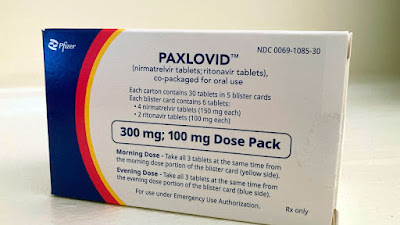You’ve got to trust your instinct
And let go of regret
There’s nothing I enjoy more than delivering a good anti-government rant.
It’s not hard finding examples of government stupidity to rant about – as a matter of fact, it’s shooting-fish-in-a-barrel easy.
But today’s rant is not the rant I thought it would be when I sat down and started ranting today.
* * * * *
After testing positive for COVID-19 for the second time a few weeks ago – despite having had six shots (including one less than two months ago) – I immediately got on the phone to my doctor and hustled me up a prescription for some Paxlovid.
 |
Prescription drugs are required to come with a document that tells you when administration of that drug is indicated, what adverse reactions may occur, what other drugs interact with the drug in question, whether the drug is appropriate for use by members of specific populations (e.g., pregnant and lactating females, children, or seniors), and so on.
The document that came with my Paxlovid prescription was almost a yard long, and it was covered on the front and back with zillions of words printed in tiny, eight-point type.
It even included structural diagrams of Paxlovid’s chemical formula. (I don’t know about you, but I would have a better chance of deciphering ancient Greek than those structural formulas.)
 |
“Why in the world does the government require Pfizer to stick a copy of this document in every Paxlovid package?” I asked myself. “There’s not a chance in the world that anyone who the drug is prescribed to actually reads it – and even if they try, no way they’re able to comprehend it.”
Just another case of the government requiring the citizenry to jump through a bunch of hoops for no good reason, I figured. Which is not exactly a “man bites dog” story, is it?
* * * * *
It turns out that I couldn’t have been wronger. When I went to the FDA website, I learned that the document included in prescription drug packages is actually intended for doctors and other healthcare professionals – not consumers.
 |
Unlike most products, prescription drugs are never sold directly to consumers – the presumption is that consumers aren’t smart enough to decide whether a prescription drug is safe and effective for them. A doctor or other professional – the legal term is “learned intermediary” – makes that decision.
From an article in U.S. Pharmacist:
[A] manufacturer of any product generally carries the responsibility to warn the user about the risks associated with the product’s use . . . . [W]hen it comes to prescription drugs, the manufacturer’s duty is to provide prescribing physicians with information about the proper use and risks of the product so that the prescriber is then better equipped to educate the consumer/patient about the drug’s use and risks; this is referred to as the “learned intermediary doctrine. “
The rationale behind this doctrine is that the complexity of the information involving prescription drugs necessitates an intermediary [e.g., a doctor or pharmacist] who can explain or interpret the benefits and risks associated with the use of the drug to the ultimate user – the patient.
That’s why the FDA’s title for that document included in my Paxlovid package is “Prescribing Information” – it’s intended to provide all the scientific information needed for a doctor to know whether the drug is safe and effective for a particular patient.
* * * * *
It makes perfect sense that a doctor be provided with comprehensive information about what illnesses a drug is intended to treat, possible adverse reactions or interactions with other drugs, and so on.
 |
What doesn’t make perfect sense is requiring that an approximately 10,000-word document containing all that information be included in each and every package of Paxlovid.
Has the FDA never heard of the internet? If a doctor wants to know more about Paxlovid, he or she can easily find the prescribing information online – right? The “Prescribing Information” document for a prescription drug can be found on the manufacturer’s website, the FDA website, the National Library of Medicine’s website, and in The Physicians’ Desk Reference – among other places.
So what’s the point of printing all that stuff on a 35-inch-long sheet of paper that’s folded up and crammed into every little box of Paxlovid that’s sent to local pharmacies?
The only person that will see that document is the patient – but the document isn’t intended to be used by patients.
So WTF, FDA?
* * * * *
311 was formed in Omaha in 1988. Since then, they’ve released 13 studio albums.
“All Mixed Up” was released on the group’s triple-platinum third album, 311, in 1995. (Rolling Stone described the album as “Beasties-cum-Chili Peppers” with “a potent reggae undertow.)
Click here to watch the music video for “All Mixed Up,” which features the band visiting a massage parlor.
Click here to buy the record from Amazon.



No comments:
Post a Comment